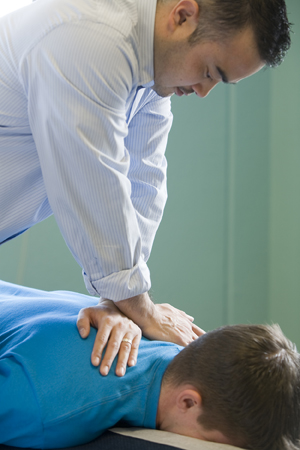Massage
What is massage?
A common natural response to pain in humans is to rub the affected area. Other mammals
have similar reactions when they feel pain or discomfort. The idea that rubbing, kneading,
or otherwise touching can help with pain is the idea behind Therapeutic Massage. With
this treatment, muscles and other soft body tissues are rubbed and manipulated, which
helps reduce pain and aids in the healing process.
Massage has also been found to be helpful emotionally. The rubbing action, while soothing
sore muscles, also works to release tension in the body creating a sense of calm and
reducing stress.

Massage therapy can help with treatment of:
-
Back pain
-
Anxiety and stress reduction
-
Depression
-
Cancer
-
HIV/AIDS
-
High blood pressure
-
Migraine headaches
-
Carpal tunnel symptoms
-
Sports or overuse injuries
-
Side effects of cancer and cancer therapy
Massaging muscles and soft tissue stimulates the nerves. It also increases blood flow
and eases stress in the muscles. Many massage methods have been developed over time.
They often use both fixed and moveable pressure methods, such as:
-
Swedish massage. This method uses long, smooth strokes. The strokes knead and compress the muscles
with deep circular movements, vibration, and tapping.
-
Shiatsu. This form of massage started in Japan. It's a lot like acupressure because it places
pressure on certain key body points.
-
Thai massage. This method incorporates yoga and some traditional Chinese medicine methods.
Massages are often done in a quiet room with soothing background music and often.
There may also be aromatherapy from candles or incense. The massage is done with the
client lying down on a massage table or sitting in a massage chair.
Research has shown that massage therapy has few risks if used correctly and provided
by a trained massage professional There are some groups of people for whom deep tissue
massage may not be advised. These include frail older adults, people with a history
of blood clots, people with severe rheumatoid arthritis, and, in some cases, individuals
who may have a history of physical abuse or trauma. If you have questions, or a chronic
health condition, check with your healthcare provider before scheduling a massage.
Tell all of your healthcare providers (conventional or complementary) about the health
methods, supplements, and medicines you use. Also let them know if you have any implantable
devices, such as a pacemaker, artificial joints, or spinal rods. This will give them
a full picture of your health. It will help make sure of safe, effective, and coordinated
care.
Massage therapy certification
Massage therapy is regulated by law. There are specific guidelines in 44 states and
the District of Columbia. The National Certification Board for Therapeutic Massage
and Bodywork (NCBTMB) has set up standards of practice.
In 2013, the NCBTMB established board certification and set up a board certification
exam. This is the highest attainable credential for massage therapists today.
The NCBTMB board certification requires that a massage therapist meets or exceeds
these requirements:
-
Passing score on the board certification exam
-
Graduation from a NCBTM Assigned School
-
Pass a criminal background check
-
Agree to uphold NCBTMB Standards of Practice and Code of Ethics
-
Verify you are legally practicing in your state or jurisdiction